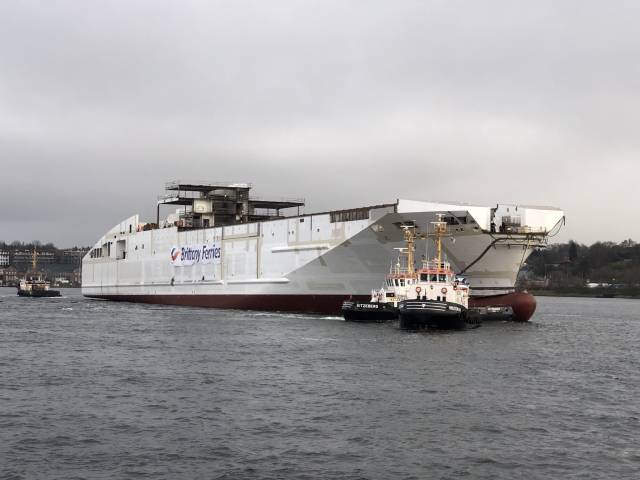#ferry - The hull of Brittany Ferries’ brand new LNG-powered cruiseferry Honfleur for English Channel service, was today given a traditional ship launching ceremony at the FSG shipyard in Flensburg, Germany.
At midday, hundreds of well-wishers, invited guests, shipyard workers and Brittany Ferries team members lined the quaysides. From there the crowds saw the completed hull of the vessel slid down the historic building slipway and into the chilly waters of the Flensburg Fjord.
The launch is the third milestone in the construction of Honfleur, following cutting of the first steel in March, and laying of the keel in August.
Since the keel was laid, 118 huge steel hull sections have been welded together on the slipway to create the 10,000 tonne six-storey behemoth before launching. The completed hull already contains all the ship’s main machinery including its efficient and environmentally-friendly LNG-electric propulsion system.
The launch marks Honfleur’s place in a long and historic line of ships to be constructed at the Flensburger Schiffbau-Gesellschaft yard (FSG) situated on the tip of Schleswig-Holstein, northern Germany. Since its foundation in 1872 more than 750 ships have been designed and built at the site.
Honfleur represents a new generation of cross-Channel ferry combining state-of-the art design and sustainable thinking with a smart, digitally-informed customer experience. The ship’s passengers will enjoy innovative experiences and fresh service concepts along with the highest standards of French onboard hospitality and catering. Altogether Honfleur will carry up to 1,680 passengers and will offer 261 cabins, two cinemas, restaurants, boutique shopping and choice of spacious passenger lounges
Honfleur will be an environmental pioneer on the English Channel. When it enters service it will be the first ship on the Channel to be powered by Liquefied Natural Gas (LNG). LNG provides major environmental advantages, reducing carbon dioxide, and cutting sulphur dioxide, nitrogen dioxide and particulate emissions to almost zero. The ship’s hull has been hydro-dynamically optimised; this combined with gas-electric propulsion machinery will reduce energy consumption while improving onboard comfort and minimising vibration and noise levels.
The launch marks the beginning of the next phase of the ship’s construction. Over the coming weeks and months, two giant superstructure ‘mega blocks’ currently en route by barge from shipyards in Poland will be hoisted into position by giant cranes, and the ferry’s attractive and modern interiors will be installed. Then, the ship will complete a series of sea trials allowing every system on board to be rigorously tested, before the first passengers board the vessel on the Portsmouth to Caen/Ouistreham route in summer 2019. The route is Brittany Ferries’ most popular carrying around 1 million passengers, 300,000 cars and 100,000 freight units each year.
Jean-Marc Roué, Brittany Ferries’ president said: “Today’s a big day for Honfleur, and a proud moment for everyone at Brittany Ferries, particularly our teams dedicated to bringing the project to fruition.”
“Honfleur will be the largest and greenest ship that Brittany Ferries has ever operated – she’ll also be the smartest: packed with new technology, innovation and comforts”, said Christophe Mathieu, CEO Brittany Ferries. “It’s a statement of our commitment to fleet renewal and long-term, sustainable development. And it will be the first of three new ships to be delivered post-Brexit, all part of a €450m investment programme to make Brittany Ferries fit for the future.”
“Now a new phase in Honfleur’s construction begins, as the superstructure is added and we work to prepare the ship to welcome its first customers this summer. We can’t wait to show them everything Honfleur has to offer.”
For more information and to follow the progress of the build from now until entry into service visit the Honfleur website.






























































